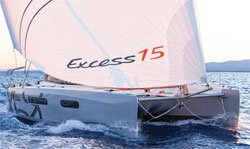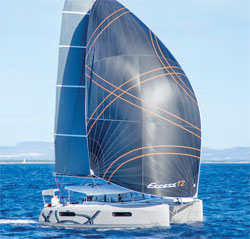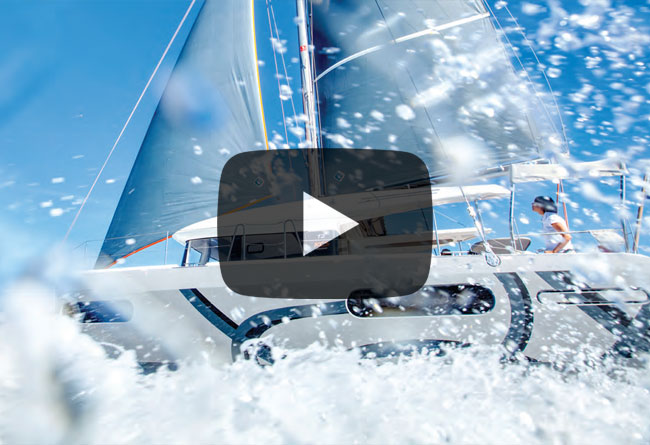
Good taste, first class naval architecture and excellent construction combined with the resources of the world’s biggest boatbuilder... the results were always going to be hard to beat
Most cruising catamarans are stodgy to sail, but Bénéteau’s new Excess brand aims to bring back the fun. Excess cats are lighter and faster, more nimble and powerful, with a sail area : displacement ratio 10 per cent higher. How much difference does 10 per cent make? We sailed the first two models in Mallorca to find out.
First impressions
Walking along a dock towards an Excess cat, the first thing you’ll notice is the exceptionally tall mast. The Excess 12 has a bridge clearance of 18.3m (59ft 11in), while the Excess 15’s masthead is 27.9m (91ft 6in) above the waterline. And that’s just the standard rig. The sportier Pulse Line rig adds another metre or two.
At sea, these yachts make a striking impression. Viewed from afar, with battleship grey sails and raked forestay the lofty rig of an Excess cat cuts the horizon like the dorsal fin of a mako shark. Get a bit closer and you’ll notice the distinctive styling by Patrick le Quémant, the famous car designer who more recently began drawing boats (including Outremers and Gunboats).
Stepping aboard via a sidedeck or the inside aft quarter of one of the hulls, which are cleverly designed to function as dinghy docks, you’ll note the excellent ergonomics – reach out in any direction and a secure handhold seems to fall naturally to hand – and then the enormous expanse of cockpit. As you take the helm or choose a seat, you can’t fail to notice the remarkable field of vision: near perfect sight lines especially from the helm and the view through the bridgedeck is so clear you can almost forget it’s there.
Design and construction
The design brief was to create a range of yachts aimed at keen, experienced sailors and restore the sensations of ‘proper’ sailing that monohull owners so often miss when they sail a cruising cat. The platform to hull length ratio is short – usually an indicator of good performance and seakeeping – and there’s more volume in the bow sections than you might expect, to damp the pitching motion under way. The hulls have a surprisingly high load-carrying capacity, which is a big bonus for blue water cruising. They have fixed keels rather than daggerboards, which does widen their tacking angle but reduces the risk of breakages and makes them easier to sail.
Regular resins, fibres and core materials are used rather than highcost carbon composites but vacuum infusion keeps the weight down. More weight and cost savings are achieved by reducing the amount of furniture – for example, open lockers rather than chests of drawers – and by building it as integrated modules instead of individual pieces.
On deck
Three wide, moulded steps take you up onto the sidedecks with handholds on both sides. The titanium-coated stanchions and mooring cleats are a nice touch and all of the sail-handling hardware is high-quality kit. There’s no forward cockpit on either model, which saves on save weight, but there’s space for a large, cushioned sunpad on the foredeck of the Excess 15.
Up at the bows there’s an alloy crossbeam braced by a slender longeron that serves as a conduit for the anchor chain, leading forward from a locker in the leading edge of the bridgedeck to a bow roller on the crossbeam that can hold a wide range of modern anchor types.
Both yachts have a long bowsprit for code sails and gennakers, hinged on the forward crossbeam and supported by twin martingale stays that are anchored to the hulls just above the waterline. A code sail can stay securely locked on its furler while the self-tacking jib is in use.
The cockpit layout is excellent. These boats are as easy to sail singlehanded as any other cruising multihull, yet they reward active participation by the rest of the crew: three or four keen sailors can have fun working the boat without getting in each other’s way. Neat, generously sized rope bins next to the primary winches stop the cockpit sole from turning into a snakes’ wedding.
The huge convertible roof has a transformative effect on the cockpit. There’s a great view of the sails from the two helm stations even when it’s shut, but the open roof gives the whole crew an equally clear view.
Rig and sailplan
The Excess cats’ masts are stepped much further aft than on the last generation of cruising cats. This is a hallmark of recent designs by VPLP and has proven merits – it reduces pitching and allows for a more balanced sailplan with a decentsized headsail rather than the ineffectual pocket handkerchiefs that you’ll see on many cruising cats.
On both models, rig geometry is relatively simple: a non-rotating mast with 9/10 fractional standing rigging, B∓R-style swept-back cap shrouds instead of a backstay and diamond shrouds (including jumpers) on one or two sets of in-line spreaders.
Both boats have an ultra-high aspect, square-top mainsail to take full advantage of the faster, less turbulent airflow at the masthead, and a large self-tacking jib that sheets to a track on the cabin top. There’s no vang or kicker – that would require a much heavier boom. Instead, the 12 has a mainsheet bridle with a powerful multi-block purchase and an electric winch; the 15 has an extra-long mainsheet traveller driven by a captive line reeler. Both of these give all the control you need for cruising. If finer adjustments are required for racing, you can rig up a flying barber-hauler.
Upwind sail area is 81.5m2 (877sq ft) on the Excess 12 and 159.5m2 (1,717sq ft) on the Excess 15. The Pulse rig option improves both models’ sail area : displacement ratios by a further 10 per cent, adding 9m2 (97sq ft) to the Excess 12 and 12.1m2 (130sq ft) to the 15. Two sets of reefing points is standard but you can have three; with a Pulse rig the first reef goes into the mainsail at around 18-20 knots true. Off the wind, a lot more power is available with a furling code zero – 67m2 (721sq ft) on the Excess 12 or 117m2 (1,259sq ft) on the 15. For downwind legs there’s an even larger gennaker – 135m2 (1,453sq ft) on the Excess 12 or 245m2 (2,637sq ft) on the 15.
Under sail
Our sea trials were off Port Adriano, near the south-west tip of Mallorca. We had a good breeze of 12-20kts true and a short, lumpy chop that the Excess cats took in their stride. To complicate our boatspeed readings there was roughly a knot of current.
It takes 30 seconds to hoist an Excess cat’s mainsail with an electric winch – you can do it manually, but with such high-aspect ratio sails you won’t want to. The twin helm positions, outboard on the aft ends of the hulls, feel absolutely right with a commanding view of the sea and the sails, all controls within arm’s reach and the rest of the crew close enough for clear communication and convivial conversations. Dyneema steering cables deliver direct, positive feedback between the wheels and rudders, which makes these boats more rewarding to steer.
Close-hauled, the Excess 12 made 5.3kts over the ground in 13kts true and 6.4kts when the breeze piped up to 18kts. It would have been faster on flat water and without a foul current. A deliberately inept, hesitant tack revealed this to be a well-mannered boat that carries its way nicely. The Excess 15 made 7.1-8.6kts closehauled in similar conditions.
Bearing away onto a reach and unfurling the code sails, we logged 7-9kts on the Excess 12 and 9-11kts on the Excess 15. The helm, indeed whole boat, comes alive with an offwind sail deployed. The numbers might be only a knot faster than a more comfort-orientated cat but the sailing experience is noticeably different and much more rewarding.

Above: off the wind these yachts really come alive when a big code sail is deployed. We logged 11 knots on the Excess 15 and while the helm was responsive and lively, the boat’s motion felt extremely relaxed.
Below: We enjoyed the same sensations aboard the Excess 12 and while the smaller boat was inevitably a bit slower it didn’t feel it

The bridgedeck clearance on both models is generous, as it should be. We did eventually get the Excess 15 to slam – only slightly and rather unfairly – by rounding up into a patch of overfalls off a headland. To its credit the yacht just ploughed on with a few slaps and judders. Other cats we’ve sailed would have bucked violently and stalled.
Under power
The boats we sailed were upgraded with bigger Yanmar diesels and three-blade folding props. With twin 45hp engines in place of the standard 2 x 29hp, the Excess 12 made 7.5kts at cruising revs without a lot of noise and slightly more than 8kts flat out. The Excess 15 cruised comfortably at 8.5kts and made 10kts at full throttle with an upgrade from twin 57hp to a pair of 80hp engines. With dual throttle controls and bow thrusters, both yachts manoeuvred easily in harbour.
Living aboard
With clear windows rather than tinted glass in the bridgedeck and lots of deck hatches that serve as skylights down below, it’s very bright and airy inside. There are three layout options for each yacht – you can have the luxury of a hull to yourself or take your whole extended family for a cruise, with six double cabins on the Excess 15 or four doubles on the 12 – and three interior design themes cater for different tastes. Despite being designed and built to save weight, the furniture has a solid, high-quality feel. A well-equipped and practical galley with proper domesticsize appliances occupies one corner of the stylish, spacious salon.
Verdict
What difference does 10 per cent make? In practice, quite a lot. It’s about sensations, not statistics. The Excess 12 and 15 both felt like “proper” sailing yachts. They reward and encourage good sail trim, they’re fun to steer and can keep an experienced crew engaged. That said, they’re quite easy to sail and not twitchy, challenging or extreme. For any cruising yacht there’s a fine balance to be struck between exhilaration and relaxation – and Excess seems to have nailed it.
Click here for more information on Excess Catamarans »
We invite you to read on and find out for yourself why Seahorse is the most highly-rated source in the world for anyone who is serious about their racing.
To read on simply SIGN up NOW
Take advantage of our very best subscription offer or order a single copy of this issue of Seahorse.
Online at:
www.seahorse.co.uk/shop and use the code TECH20
Or for iPad simply download the Seahorse App at the iTunes store



